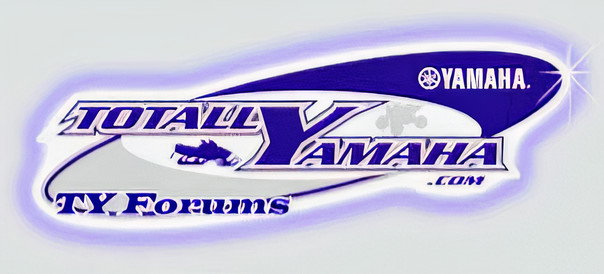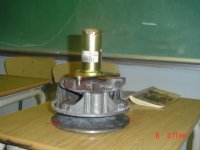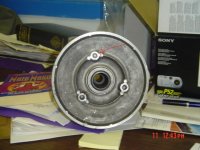Cam
New member
I have read the posts on removal-will this polaris spider tool work on this clutch, and the big question is how does one hold down the fixed sheave when torquing on the bar or snipe? Hope that the pictures turns up. Have other questions but one baby step at a time. Thanks Cam 

Attachments
viperkuku
New member
- Joined
- Jun 17, 2004
- Messages
- 19
Looks like that would work, to hold the bottom shieve, I made a tool with a flat piece of iron and that had some pegs that fit in the 3 slots in the bottom shieve, I think they sell these also. make sure you heat the locktite to get it apart, I used my deep fat turkey fryer and heated water up and dunked it in and it worked great.
800
New member
you'll have to get the holder for the fixed sheave, the polaris tool will turn the spider fine. Lots of heat, and oh yeah in case you didn't know it's left hand thread.
Wilson
New member
I just used a little propane torch ,it worked fine for me . And the left hand thread tip is an important one .
Yamadogger
New member
Holding Sheave
One way to hold your primary sheave stationary while loosening the spider is to drill some holes in you work bench (my work bench is made of 1/2" plywood) and bolt it down. I took my clutch off and taped a piece of paper on the back side of my clutch and then rubbed the paper with a pencil to transfer the 6 bolt holes to the paper. Then put the paper on your bench and drill out the 6 holes. I made them a little over size to make lining it up easier. Then get yourself 6 metric bolts (I don't recall the size anymore) and bolt it down threading the bolts in from the bottom up. The only thing to be careful of is to not bottom out the bolts and break out the face of you inner sheave so make sure you get the right length bolts. I've done about 6 clutches this way and it works great and all it costs is a few bucks for the bolts and a little time to drill the holes in your bench. I know it's not glamorous but it works great.
One way to hold your primary sheave stationary while loosening the spider is to drill some holes in you work bench (my work bench is made of 1/2" plywood) and bolt it down. I took my clutch off and taped a piece of paper on the back side of my clutch and then rubbed the paper with a pencil to transfer the 6 bolt holes to the paper. Then put the paper on your bench and drill out the 6 holes. I made them a little over size to make lining it up easier. Then get yourself 6 metric bolts (I don't recall the size anymore) and bolt it down threading the bolts in from the bottom up. The only thing to be careful of is to not bottom out the bolts and break out the face of you inner sheave so make sure you get the right length bolts. I've done about 6 clutches this way and it works great and all it costs is a few bucks for the bolts and a little time to drill the holes in your bench. I know it's not glamorous but it works great.
What kind of tool is needed to remove the primary clutch from the crank?
Is it possible to make one? Could anyone post a pic of what they look like?
Is it possible to make one? Could anyone post a pic of what they look like?
Yamadogger
New member
Home Made Puller
The simplest method would be to buy a clutch puller from Dennis Kirk for about $20. I, on the other hand like to do things the hard way and I use a metric bolt (I believe it's 18 mm but I can't remember the pitch). Anyway, I ended up ordering one on the internet as I could not find one locally. After removing the bolt that holds your primary clutch to the crankshaft, simply insert the end of your grease gun and pump the cavity full of grease, taking care to not get any air bubbles inside. As you are pumping the grease in let the grease push the end of the gun out as it fills the clutch cavity. Pump until the entire cavity is filled. Then take your newly acquired bolt and thread it in and use a ratchet to tighten. The force of the bolt on the grease develops a tremendous amount of hydraulic pressure and will pop the clutch off in seconds. It takes a surprisingly small amount of torque to get a clutch off using this method. The only disadvantage is that you need to clean the grease out of the clutch cavity once it's off but it's not a real big deal. A clutch puller is definitely easier but I've never been a fan of hammering on the end of the puller with a hammer or using an impact to get the clutch off. Either way works just a matter of how much screwing around you want to do.
The simplest method would be to buy a clutch puller from Dennis Kirk for about $20. I, on the other hand like to do things the hard way and I use a metric bolt (I believe it's 18 mm but I can't remember the pitch). Anyway, I ended up ordering one on the internet as I could not find one locally. After removing the bolt that holds your primary clutch to the crankshaft, simply insert the end of your grease gun and pump the cavity full of grease, taking care to not get any air bubbles inside. As you are pumping the grease in let the grease push the end of the gun out as it fills the clutch cavity. Pump until the entire cavity is filled. Then take your newly acquired bolt and thread it in and use a ratchet to tighten. The force of the bolt on the grease develops a tremendous amount of hydraulic pressure and will pop the clutch off in seconds. It takes a surprisingly small amount of torque to get a clutch off using this method. The only disadvantage is that you need to clean the grease out of the clutch cavity once it's off but it's not a real big deal. A clutch puller is definitely easier but I've never been a fan of hammering on the end of the puller with a hammer or using an impact to get the clutch off. Either way works just a matter of how much screwing around you want to do.
Cam
New member
Back of my stationary sheave
Yamadogger, the back of my stationary sheave only has the three holes shown (not quite 3/8")and these do not have threads. Any suggestions, I like your idea, can't bolt it down through the centre, perhaps some dogs (wood?) on the outer edge? Thanks Cam
Yamadogger, the back of my stationary sheave only has the three holes shown (not quite 3/8")and these do not have threads. Any suggestions, I like your idea, can't bolt it down through the centre, perhaps some dogs (wood?) on the outer edge? Thanks Cam
Attachments
Yamadogger
New member
Sheave
Sorry - I assumed you had the newer style clutch that has 6 threaded holes on the back. In looking at the back of your clutch what if you did the paper rub trick I described and transfered the 3 holes to your bench. Then drill them out and get some bolts that are about 1" longer than the thickness of your bench and slightly smaller than the holes in the back of your clutch. Stick the bolts through your bench from the bottom and toss a washer and nut on the top and tighten the crap out of them. When you're done you should have the exposed threads from the three bolts sticking up through your bench. If you can suck the nut down into the wood a ways then it should be stiff enough to hold your clutch when you're cranking on it. Then set your clutch on top of the bolts so the bolts stick up into the 3 holes in the back of the clutch. Using your spider tool you should be able to carefully remove the spider while keeping a close eye on the bolts to make sure they don't bend and break out the back side of your sheave. I don't know if this will work but it would be worth a try. If not you'll have to weld up a metal jig to hold the clutch. Let me know if this works.
Sorry - I assumed you had the newer style clutch that has 6 threaded holes on the back. In looking at the back of your clutch what if you did the paper rub trick I described and transfered the 3 holes to your bench. Then drill them out and get some bolts that are about 1" longer than the thickness of your bench and slightly smaller than the holes in the back of your clutch. Stick the bolts through your bench from the bottom and toss a washer and nut on the top and tighten the crap out of them. When you're done you should have the exposed threads from the three bolts sticking up through your bench. If you can suck the nut down into the wood a ways then it should be stiff enough to hold your clutch when you're cranking on it. Then set your clutch on top of the bolts so the bolts stick up into the 3 holes in the back of the clutch. Using your spider tool you should be able to carefully remove the spider while keeping a close eye on the bolts to make sure they don't bend and break out the back side of your sheave. I don't know if this will work but it would be worth a try. If not you'll have to weld up a metal jig to hold the clutch. Let me know if this works.
Last edited:
Harvey
New member
ya,you dont need threads in it,just 3 pins sticking up to go into the holes in the rear of the primary,then heat it up real good and turn it off with your spider tool.we did 6 of these along with secondarys last night.-Harvey


